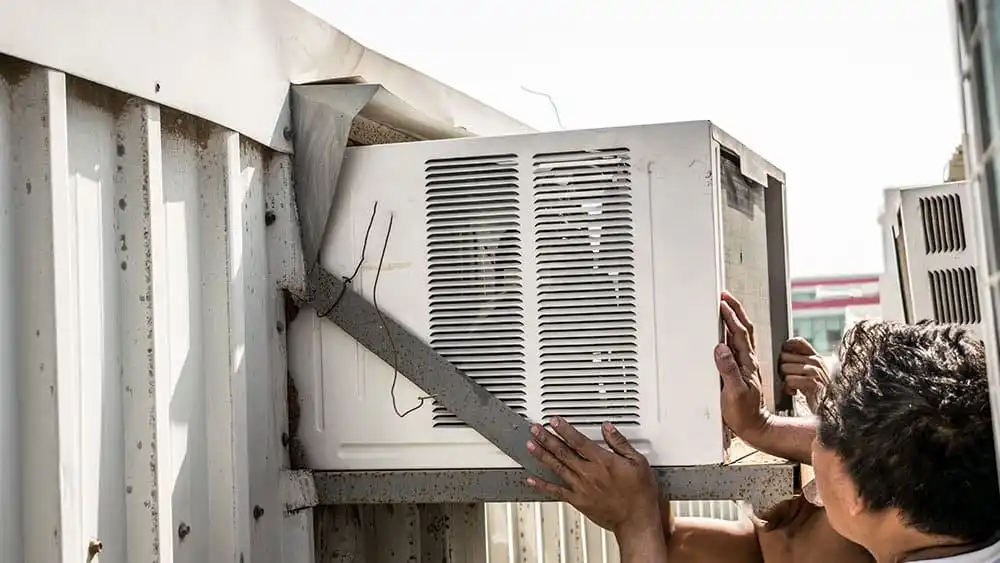Air condition pre-removal inspections:
Preparation and planning are the foundations of any successful do-it-yourself project. Get the right equipment together, like a screwdriver, pliers or an adjustable wrench. Because of their weight, air conditioners are usually best moved and stored with the help of a buddy. You can go forward on your own if you are confident in your physical strength.
Make sure to turn off the power to your air conditioner for everyone’s safety. In addition, if you know which switch to flip in the main switchboard, you can cut power to the entire building. Remove any clutter or potential hazards from your workspace. If you do not want drip tray splashes on the floor, a towel or sheet under the tray is a good idea.
Remove the ac before putting in the store:
Take the air conditioner out of the window before storing it, as it is a large appliance. Do not attempt this task without the assistance of your pal. To get your window air conditioner working again, peel away any sealant from its edges. Simply pull the AC’s handle and pull it away from the wall to remove it.
Don’t forget to give it some bottom-up support and keep it from toppling over. Here’s where having a buddy or some muscle would be helpful. Once the air conditioner is flexible enough, tip it so that the water that remains in the drip tray drains outdoors.
At last, fully retract the air conditioner and lower the window. Cover up the air conditioner hole if it was carved out to accommodate the unit. These measures form the basis for stowing away window air conditioners.
Clean the dust and grime out of your air conditioner:
It’s not safe to put a dirty air conditioning in storage. Furthermore, if water has collected in the drip trays, mold and fungus can grow. Therefore, before putting your air conditioner away for the winter, it is an excellent idea to give it a complete cleaning.
The initial action in preparing an air conditioner for storage is to clean the filter. Run it under some water to clean it. Remove the dust and grime that has accumulated on the filter with a soft brush. If the grime won’t come off with a simple brushing, try a solution of soap and vinegar instead. Water it down once more, put the filter somewhere it may dry out.
Condensate the pan and air filters:
Filters in central air conditioning units collect particles of dirt and dust. Remove your AC unit from storage and give it a thorough cleaning or replace any dirty parts. The condensate pan too, needs to be spotless before it can be installed. You should look for corrosion or rust and fix it with a product that removes rust if you find any.
Take off the grills and covers outside:
Remove the grills and covers from your air conditioner’s exterior before putting it away for the season. This is crucial to guarantee that no dust or dirt settles on them during storage, which could cause blockage or other problems when you need to reinstall them.
Use a breathable material to cover the unit:
Before putting your air conditioner into storage, make sure you cover it with a permeable material. This will allow any water that is within the appliance to escape while keeping dust, grime and debris out. Use anything that can keep water out while still letting air in, like a tarp.
Keep the device in a dry location:
Keep your air conditioner away from damp areas and moisture sources while not in use. Water can cause irreversible damage to an air conditioner, so it’s best to keep it in a dry place like a basement, attic or garage.
Let’s say you are stuck keeping your cooling system in a damp basement or attic. If that’s the case, you might want to think about installing a dehumidifier to stop condensation from accumulating on the device and leading to corrosion or mold.
Keep your ac unit vertical while not in use:
Always keep your AC unit vertical when not in use. The compressor can be damaged if the unit is stored on its back or side. This can cause costly breakdowns that require extensive upkeep and repair. The oil can also settle if you store the unit upright.
Use the original packaging to keep your device safe:
Keeping an AC in its original packaging is recommended. This shields the component and keeps dust out. When you no longer possess the packaging for your device, you can keep it dust-free over the next few months by covering it with a trash bag.
Cover it if you don’t put it away:
If you cannot take the air conditioner outside and put it away for the winter, you should at least protect it from the elements with a cover made for air conditioners. The machine will last longer if it is protected from draughts, which can be avoided by covering the unit. You can find stores selling covers both locally and online. A/C units are pricey investments that should last for as long as possible with little maintenance and repair needs.
You can keep your air conditioner in good working order and prevent the wear and tear that comes with years of use by scheduling routine
. In addition to addressing issues as they emerge, preventative maintenance on your air conditioner can save you money in the long run by avoiding the need for expensive repairs in the future. When summer rolls around again, you’ll want to know that your air conditioner is in tip-top shape to keep you cool and comfortable.

